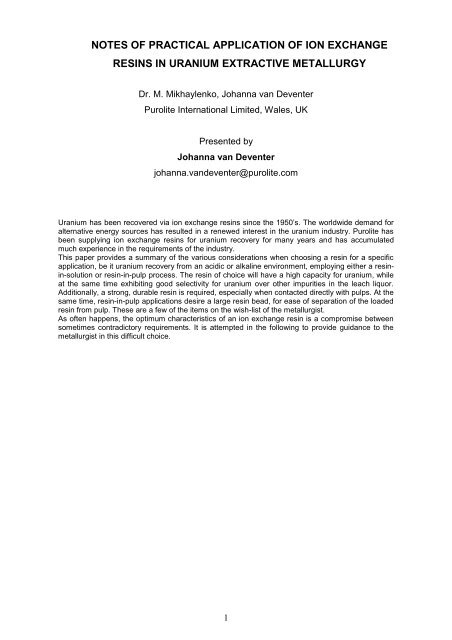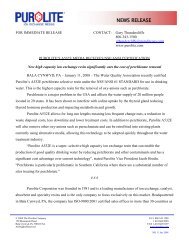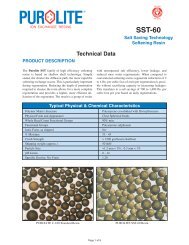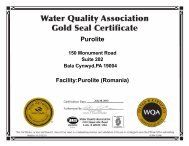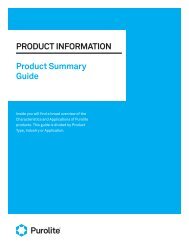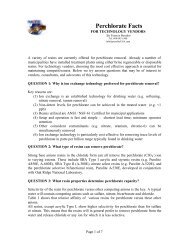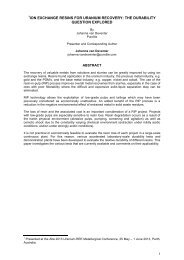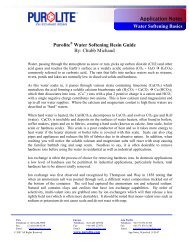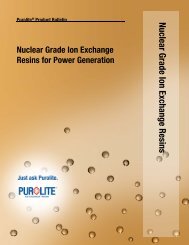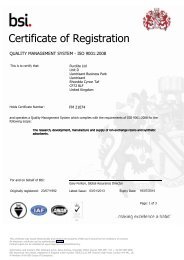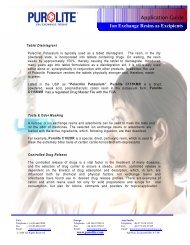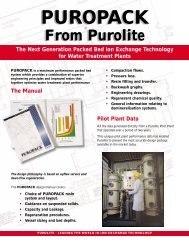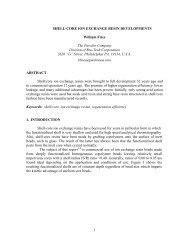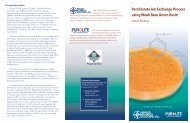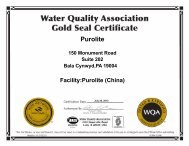Notes of practical application of ion exchange resins in ... - Purolite
Notes of practical application of ion exchange resins in ... - Purolite
Notes of practical application of ion exchange resins in ... - Purolite
- No tags were found...
You also want an ePaper? Increase the reach of your titles
YUMPU automatically turns print PDFs into web optimized ePapers that Google loves.
South African researchers reported foul<strong>in</strong>g <strong>of</strong> an<strong>ion</strong> <strong>exchange</strong> <strong>res<strong>in</strong>s</strong> by polymerized cobalt cyanidespecies <strong>in</strong> the case <strong>of</strong> sorpt<strong>ion</strong> <strong>of</strong> uranium from acidified gold cyanidat<strong>ion</strong> tails.1.2 METHODS OF LEACHING AND SORPTIONThere are two pr<strong>in</strong>ciple methods <strong>of</strong> ore process<strong>in</strong>g: extract<strong>ion</strong> <strong>of</strong> ore from the ground (it may beunderground m<strong>in</strong>es or open pits) and <strong>in</strong> situ treatment. Extracted ore is transported, crushed,beneficiated and milled for further process<strong>in</strong>g. When <strong>in</strong> situ leach (ISL) is used, the ore rema<strong>in</strong>sunderground and uranium is dissolved by appropriate lixiviants directly from the ore body. The ISLproduces “clean” PLS with Total Suspended Solids (TSS) less than 50 ppm.Leach<strong>in</strong>g <strong>of</strong> uranium from milled ore can be arranged <strong>in</strong> the follow<strong>in</strong>g ways: Heap leach<strong>in</strong>g. This method is the most economical for process<strong>in</strong>g <strong>of</strong> low gradeores. Batch leach<strong>in</strong>g. This method can be modified as autoclave leach<strong>in</strong>g, tank leach<strong>in</strong>g,vat leach<strong>in</strong>g.For our considerat<strong>ion</strong> it is important to notice that heap leach<strong>in</strong>g and tank leach<strong>in</strong>g, followed bysedimentat<strong>ion</strong> pond and CCD respectively, produce “clean” PLS similar to those obta<strong>in</strong>ed from ISLoperat<strong>ion</strong>s.Leach<strong>in</strong>g <strong>in</strong> autoclaves or tanks produces mixtures <strong>of</strong> f<strong>in</strong>ely milled ore and PLS. Such mixtures,known as “pulps”, can be treated further <strong>in</strong> two ways:1. M<strong>in</strong>eral solids are filtered <strong>of</strong>f; clarified solut<strong>ion</strong> cont<strong>in</strong>ues to the uranium recoverystep.2. Sorpt<strong>ion</strong> <strong>of</strong> uranium is carried out directly from the pulp, def<strong>in</strong>ed as ‘res<strong>in</strong>-<strong>in</strong>-pulp’(RIP). Uranium pulp can be supplied as by-product <strong>of</strong> other metals recovery like gold (<strong>in</strong>South Africa) or copper. For some types <strong>of</strong> ores, leach<strong>in</strong>g <strong>of</strong> uranium from milled ore can becomb<strong>in</strong>ed with its sorpt<strong>ion</strong> <strong>in</strong> the same vessel, called ‘res<strong>in</strong>-<strong>in</strong>-leach’ (RIL). From standpo<strong>in</strong>t<strong>of</strong> sorpt<strong>ion</strong> technique it is very similar to RIP.2. DESIRABLE RESIN CHARACTERISTICSThe comb<strong>in</strong>at<strong>ion</strong> <strong>of</strong> different process parameters creates a variety <strong>of</strong> condit<strong>ion</strong>s for exploitat<strong>ion</strong> <strong>of</strong><strong>ion</strong> <strong>exchange</strong> <strong>res<strong>in</strong>s</strong> for uranium recovery. These condit<strong>ion</strong>s, <strong>in</strong> turn, have their reflect<strong>ion</strong>s <strong>in</strong> res<strong>in</strong>properties required for the best economical performance.The res<strong>in</strong> properties are to be chosen to suit specific work<strong>in</strong>g condit<strong>ion</strong>s. Start<strong>in</strong>g from the top <strong>of</strong> thehierarchical pyramid, the follow<strong>in</strong>g general requirements apply: High operat<strong>in</strong>g capacity Efficient regenerat<strong>ion</strong> Service life durabilityEach <strong>of</strong> these requirements splits on to lower levels:High operat<strong>in</strong>g capacity means: High chemical aff<strong>in</strong>ity <strong>of</strong> the res<strong>in</strong> funct<strong>ion</strong>al groups towards uranyl compounds4
High selectivity <strong>of</strong> the funct<strong>ion</strong>al groups towards uranyl compounds; i.e. loweraff<strong>in</strong>ity for undesirable species present <strong>in</strong> the feed source High k<strong>in</strong>etics <strong>of</strong> <strong>ion</strong> <strong>exchange</strong>, both dur<strong>in</strong>g adsorpt<strong>ion</strong> and elut<strong>ion</strong>The follow<strong>in</strong>g properties def<strong>in</strong>e the efficiency <strong>of</strong> regenerat<strong>ion</strong>: Applicability <strong>of</strong> available reagents Obta<strong>in</strong><strong>in</strong>g <strong>of</strong> lower volume <strong>of</strong> more concentrated desorbates Prevent<strong>ion</strong> <strong>of</strong> foul<strong>in</strong>g impurities build-up Low residual content <strong>of</strong> uranium <strong>in</strong> the regenerated res<strong>in</strong>The service life durability is def<strong>in</strong>ed by the follow<strong>in</strong>g ma<strong>in</strong> factors: Mechanical strength Resistance to chemical foul<strong>in</strong>g or degradat<strong>ion</strong> Resistance to osmotic shockAs always, the optimum characteristics <strong>of</strong> an <strong>ion</strong> <strong>exchange</strong> res<strong>in</strong> is a compromise betweensometimes contradictory requirements. It means that to enforce one specific property <strong>of</strong> the res<strong>in</strong>we have to sacrifice some others. To ensure the best res<strong>in</strong> for a particular project is chosen, allthese aspects have to be considered. This can be a daunt<strong>in</strong>g task. Some <strong>of</strong> the res<strong>in</strong> requirementsare discussed <strong>in</strong> more detail below.1.3 OPERATING CAPACITY OF THE RESINOver the years, many types <strong>of</strong> <strong>ion</strong> <strong>exchange</strong> <strong>res<strong>in</strong>s</strong> have been tried for the extract<strong>ion</strong> <strong>of</strong> uranium.However, so far only strong base an<strong>ion</strong> <strong>exchange</strong> <strong>res<strong>in</strong>s</strong> are widely used across the world to extractnatural uranium (both type I and type II). Though some authors advocate different performance <strong>of</strong>these two res<strong>in</strong> types, <strong>Purolite</strong> has not observed any mean<strong>in</strong>gful difference. In further narrat<strong>ion</strong>, nodifferentiat<strong>ion</strong> is made between these types <strong>of</strong> SBA <strong>res<strong>in</strong>s</strong>.Uranium operat<strong>in</strong>g capacity <strong>of</strong> SBA <strong>res<strong>in</strong>s</strong> changes <strong>in</strong> correspondence with their total capacitydef<strong>in</strong>ed for the chloride-an<strong>ion</strong>, as shown <strong>in</strong> Figure 1.The data illustrated <strong>in</strong> Figure 1 was generated for sulfuric acid artificial PLS with a uraniumconcentrat<strong>ion</strong> <strong>of</strong> 100 mg/L. This dependence is more or less accurate for all typical SBA <strong>res<strong>in</strong>s</strong> used<strong>in</strong> the <strong>in</strong>dustry.It becomes clear that gel type <strong>res<strong>in</strong>s</strong>, due to their higher volume capacity, will generally have higheruranium capacities than porous <strong>res<strong>in</strong>s</strong>.The uranium load<strong>in</strong>g capacity <strong>of</strong> a res<strong>in</strong> with common strong base groups is limited. <strong>Purolite</strong> has<strong>in</strong>troduced a new products l<strong>in</strong>e <strong>of</strong> SBA <strong>res<strong>in</strong>s</strong> employ<strong>in</strong>g a different quaternary ammoniumfunct<strong>ion</strong>al group. These new products exhibit much higher uranium load<strong>in</strong>gs, when compared tores<strong>in</strong> with convent<strong>ion</strong>al funct<strong>ion</strong>al groups. Data <strong>in</strong> Table 1 compare the uranium load<strong>in</strong>g capacities<strong>of</strong> these new <strong>res<strong>in</strong>s</strong>, both gel-type and macroporous, to that obta<strong>in</strong>ed for convent<strong>ion</strong>al res<strong>in</strong>.5
Uranium Uptake, g per litre5550Experimental DataPolynomial Fit for the Experimental DataUpper 95% Confidence LimitLower 95% Confidence Limit45403530Y =95.00316-131.17227 X+60.47479 X 2251.40 1.45 1.50 1.55 1.60 1.65 1.70 1.75Volume Capacity, eq/litre [Cl - ]Figure 1: Dependence <strong>of</strong> uranium uptake on chloride capacity <strong>of</strong> strong base an<strong>ion</strong> gelType I res<strong>in</strong> (<strong>Purolite</strong> ® ).Table 1 represents data on uranium fixat<strong>ion</strong> obta<strong>in</strong>ed under the same condit<strong>ion</strong>s as for Figure 1. Itis remarkable that while res<strong>in</strong> no. 1 with common strong base an<strong>ion</strong> groups matches theapproximat<strong>ion</strong> curve pretty well, the other SBA <strong>res<strong>in</strong>s</strong>, numbers 2, 3 and 4 hav<strong>in</strong>g differentquaternary ammonium groups demonstrate much higher uranium load<strong>in</strong>gs.Table 1 Uranium fixat<strong>ion</strong> on <strong>res<strong>in</strong>s</strong> with different funct<strong>ion</strong>alityIon <strong>exchange</strong> res<strong>in</strong> Total volume capacityper chloride, eq/lUraniumfixat<strong>ion</strong>, g/lRatio <strong>of</strong> U fixat<strong>ion</strong> tochloride capacity, g/eq1 PFA600/4740 (gel) a 1.63 39.8 24.42 A560/4758 (porous) b 1.18 46.7 39.63 A660/4759 (gel) b 1.45 53.0 36.64 PFA460/4783 (porous) b 1.37 55.0 40.2a – convent<strong>ion</strong>alb – “new”Even porous <strong>Purolite</strong> ® A560/4758 res<strong>in</strong> with the lowest chloride capacity has higher uranium fixat<strong>ion</strong>than common gel type PFA600/4740.Higher operat<strong>in</strong>g capacity presents to the user such advantages as: Lower res<strong>in</strong> flow rate Less res<strong>in</strong> <strong>in</strong>ventory and less capital expenditure (CAPEX) <strong>of</strong> the project Less operat<strong>in</strong>g expenditures (OPEX) related to auxiliary operat<strong>ion</strong>s associated with theres<strong>in</strong> flow rate: res<strong>in</strong> losses, energy, r<strong>in</strong>s<strong>in</strong>g waters, wastes, man power etcFor further comparison, as shown <strong>in</strong> Table 2, three <strong>Purolite</strong> ®<strong>res<strong>in</strong>s</strong> were <strong>in</strong>vestigated <strong>in</strong> thelaboratory on the solut<strong>ion</strong> <strong>of</strong> the follow<strong>in</strong>g composit<strong>ion</strong> (g/l): Uranium – 0.104; Sulfate – 10.5; Nitrate6
– 0.50; Chloride – 1.05; Fe 3+ – 1.02; Al 3+ – 0.35; Si – 0.06; pH = 2.0. Such solut<strong>ion</strong> simulates typicalpregnant solut<strong>ion</strong> produced by sulfuric acid ISL operat<strong>ion</strong>s. The <strong>res<strong>in</strong>s</strong> tested were: A500U/2788: macroporous, size distribut<strong>ion</strong> 800-1300 µm (92% >800 µm), “convent<strong>ion</strong>al”product PFA460/4783: gel-type, uniform beads, size distribut<strong>ion</strong> 520 – 630 µm, “new” product PFA600/4740: gel-type, uniform beads, size distribut<strong>ion</strong> 520 – 630 µm, “convent<strong>ion</strong>al” productTable 2 Comparison <strong>of</strong> general sorpt<strong>ion</strong> parameters for different strong base an<strong>ion</strong> <strong>res<strong>in</strong>s</strong><strong>Purolite</strong> ® <strong>res<strong>in</strong>s</strong>A 500U/2788 a PFA460/4783 b PFA600/4740 aSorpt<strong>ion</strong> time till breakthrough po<strong>in</strong>t, hours 5.90 17.0 14.2Uranium fixat<strong>ion</strong> on the res<strong>in</strong> at breakthroughpo<strong>in</strong>t, g/la – convent<strong>ion</strong>alb – “new”5.46 15.7 13.1The laboratory results obta<strong>in</strong>ed were used to calculate the sorpt<strong>ion</strong> time till breakthrough po<strong>in</strong>t(accepted for uranium as 0.002 g/l) and the res<strong>in</strong> capacities at the breakthrough po<strong>in</strong>t for a full-scaleplant; it was accepted that fixed bed filter has diameter 4 m, res<strong>in</strong> bed volume is 28.6 m 3 and feedflow rate is 259 m 3 /hour.The results presented <strong>in</strong> Table 2 showed that the time until uranium breakthrough for “new”PFA460/4783 res<strong>in</strong> was about 20% more, and uranium fixat<strong>ion</strong> was also 20% more than forcommon PFA600/4740 at the same res<strong>in</strong> bed volume and PLS flow rate. The uranium load<strong>in</strong>gobta<strong>in</strong>ed was almost three times higher for the “new” PFA460/4783 than for “convent<strong>ion</strong>al”A500U/2788, with a similar <strong>in</strong>crease <strong>in</strong> the time till breakthrough.1.4 RESIN LOSSESOne <strong>of</strong> the most frequent quest<strong>ion</strong>s is about res<strong>in</strong> losses rate.Res<strong>in</strong> leaves the process loop generally with flows <strong>of</strong> barren pulp or solut<strong>ion</strong>; we can nom<strong>in</strong>ate suchlosses as ‘technological’ ones. Some losses can also be are attributed to mishandl<strong>in</strong>g, spillage etc.Under normal process condit<strong>ion</strong>s, res<strong>in</strong> breaks down to produce f<strong>in</strong>e particles which pass throughthe screen<strong>in</strong>g circuits.Res<strong>in</strong> breaks down due to different physical forces: compress<strong>ion</strong> failure percussive act<strong>ion</strong> abras<strong>ion</strong> osmotic shockLet’s consider them separately.Compress<strong>ion</strong> failure is more typical for <strong>res<strong>in</strong>s</strong> work<strong>in</strong>g <strong>in</strong> columns <strong>in</strong> fixed beds. This is the mostcommon design for <strong>in</strong>-situ and heap leach operat<strong>ion</strong>. In the fixed beds the res<strong>in</strong> is exposed to al<strong>in</strong>ear pressure gradient attributed to solut<strong>ion</strong> flow along the column axis.7
Perfect beads (%)100806040200300 350 400 450 500 550 600 650 700Break<strong>in</strong>g weight (g/bead)Figure 2: Relat<strong>ion</strong> between ball mill and dynamometric tests (<strong>Purolite</strong> © .)It is <strong>in</strong>terest<strong>in</strong>g to notice that break<strong>in</strong>g weight and ball mill parameters don’t necessarily collate, asillustrated by Figure 2. The break<strong>in</strong>g weights <strong>of</strong> a number <strong>of</strong> <strong>res<strong>in</strong>s</strong> were compared to the results <strong>of</strong>the Ball Mill test.It is logical to assume that res<strong>in</strong> wear rate is l<strong>in</strong>ked with res<strong>in</strong> flow rate <strong>in</strong> the process. Higher res<strong>in</strong>flow rates will result <strong>in</strong> higher collis<strong>ion</strong>s frequency, collis<strong>ion</strong> momentum and frequency <strong>of</strong>regenerat<strong>ion</strong>s. The comb<strong>in</strong>ed effect <strong>of</strong> these will result <strong>in</strong> <strong>in</strong>creased breakage <strong>of</strong> the res<strong>in</strong>.Res<strong>in</strong> flow rate is determ<strong>in</strong>ed by uranium mass balance <strong>of</strong> the process. Metal flow (kg/hour) throughthe plant must be equilibrated by flow <strong>of</strong> res<strong>in</strong> <strong>exchange</strong> capacity. The latter is def<strong>in</strong>ed asmultiplicat<strong>ion</strong> <strong>of</strong> res<strong>in</strong> operat<strong>in</strong>g capacity (kg/m 3 R ) by res<strong>in</strong> flow (m 3 R /hour). Thus we see that <strong>res<strong>in</strong>s</strong>with higher operat<strong>in</strong>g capacity have advantage due to less wear rate, other condit<strong>ion</strong>s be<strong>in</strong>g equal.Averaged res<strong>in</strong> losses reported by operat<strong>in</strong>g uranium RIP plants are 175-220 g <strong>of</strong> dry res<strong>in</strong> per 1tonne <strong>of</strong> treated ore or about 60-80 m 3 res<strong>in</strong> per 100 thousand tones <strong>of</strong> treated ore. It representsabout 20% make-up <strong>of</strong> the total res<strong>in</strong> <strong>in</strong>ventory. Actual make-up can vary from 15 to 45%depend<strong>in</strong>g on different operat<strong>in</strong>g parameters.1.5 GRADING OF RESINGrad<strong>in</strong>g <strong>of</strong> <strong>ion</strong> <strong>exchange</strong> <strong>res<strong>in</strong>s</strong> will comply with the follow<strong>in</strong>g demands: Effective separat<strong>ion</strong> from productive leach media, either, clean solut<strong>ion</strong> or dense pulp. Low hydrodynamic resistance by res<strong>in</strong> bed to solut<strong>ion</strong> flow <strong>in</strong> fixed beds (low pressure dropacross the bed). This is provided by narrow size distribut<strong>ion</strong> <strong>of</strong> the res<strong>in</strong> beads.<strong>Purolite</strong> produces <strong>res<strong>in</strong>s</strong> with different grad<strong>in</strong>g depend<strong>in</strong>g on particular <strong>applicat<strong>ion</strong></strong>: Pur<strong>of</strong><strong>in</strong>e grade: mean diameter 520-620 μm with uniformity coefficient 1.2 max. Special grade for RIP processes: 1% max below 710 μm and 5% max below 800 μm.9
1.6 POLYMER MATRIX AND MOISTURE RETENTIONMost <strong>of</strong> the commercial <strong>res<strong>in</strong>s</strong> suggested on the world market are made <strong>of</strong> styrene as a monomerand div<strong>in</strong>ylbenzene (DVB) as a crossl<strong>in</strong>ker. Structure <strong>of</strong> the <strong>res<strong>in</strong>s</strong> can be either gel or porous.Characteristics <strong>of</strong> porous structure depend on the res<strong>in</strong> manufactur<strong>in</strong>g method.Be<strong>in</strong>g funct<strong>ion</strong>alized with quaternary ammonium the res<strong>in</strong> becomes very hydrophilic. It reta<strong>in</strong>s waterdue to hydrat<strong>ion</strong> and coord<strong>in</strong>at<strong>ion</strong> via hydrogen bond<strong>in</strong>g. Typically such water retent<strong>ion</strong> varies fordifferent <strong>res<strong>in</strong>s</strong> from 45 to 60% depend<strong>in</strong>g on the extent <strong>of</strong> res<strong>in</strong> crossl<strong>in</strong>k<strong>in</strong>g and the concentrat<strong>ion</strong><strong>of</strong> funct<strong>ion</strong>al groups <strong>in</strong> the polymer matrix.Porosity, extent <strong>of</strong> crossl<strong>in</strong>k<strong>in</strong>g and moisture retent<strong>ion</strong> capacity play an important role <strong>in</strong> operat<strong>in</strong>gperformance under real condit<strong>ion</strong>s. Comb<strong>in</strong>at<strong>ion</strong> <strong>of</strong> these parameters def<strong>in</strong>es operat<strong>in</strong>g capacity <strong>of</strong>the res<strong>in</strong>, rate <strong>of</strong> <strong>ion</strong> <strong>exchange</strong> react<strong>ion</strong>, osmotic and mechanical resistance, and resistance to silicafoul<strong>in</strong>g.Eventually, optimized performance is a trade-<strong>of</strong>f among these parameters.High k<strong>in</strong>etics <strong>of</strong> <strong>exchange</strong> is an important parameter which has great <strong>in</strong>fluence on res<strong>in</strong>performance especially for PLS <strong>of</strong> low grade as <strong>of</strong> restorat<strong>ion</strong> wells for example. For process<strong>in</strong>g <strong>of</strong>low grade solut<strong>ion</strong>s, say below 30 ppm <strong>of</strong> uranium, the macroporous or low-crossl<strong>in</strong>ked gel <strong>res<strong>in</strong>s</strong>are preferable, due to their higher k<strong>in</strong>etics and total efficiency.For high grade solut<strong>ion</strong>s, convent<strong>ion</strong>ally above 50-60 ppm, higher res<strong>in</strong> capacity is preferable. Gel<strong>res<strong>in</strong>s</strong> typically have higher total capacity than macroporous <strong>res<strong>in</strong>s</strong>. For example, total capacity asper chloride an<strong>ion</strong> is around 1.2 eq/l for <strong>Purolite</strong> ® A500U/2788 (macroporous) and 1.6 eq/l for<strong>Purolite</strong> ® PFA600/4740 (gel-type) res<strong>in</strong>.1.7 SILICA FOULINGSilica foul<strong>in</strong>g rema<strong>in</strong>s one <strong>of</strong> the ma<strong>in</strong> concerns when a new project is <strong>in</strong>vestigated. The chemicalbehavior <strong>of</strong> silica is complicated and difficult to control.Silica foul<strong>in</strong>g issues are typical for acid leach condit<strong>ion</strong>s. It is known that silica tends topolycondensat<strong>ion</strong> at acidic pH with format<strong>ion</strong> <strong>of</strong> large polymeric molecules which <strong>in</strong> turn formcolloidal particles. Thus, <strong>in</strong> acidic solut<strong>ion</strong> we face monomeric an<strong>ion</strong>ic forms <strong>of</strong> silica as well aspolymerized and colloidal forms. Reported solubility <strong>of</strong> monomeric silica is around 300 ppm. In realproductive leach media silica concentrat<strong>ion</strong>s can range from about 400 to 2,000 ppm.Monomeric form <strong>of</strong> silica has low aff<strong>in</strong>ity for strong base funct<strong>ion</strong>ality <strong>of</strong> the res<strong>in</strong>. It can be easilyremoved from the res<strong>in</strong> at uranium desorpt<strong>ion</strong> stage. It is assumed that all forms <strong>of</strong> silica exist<strong>in</strong>g <strong>in</strong>the solut<strong>ion</strong> participate <strong>in</strong> the foul<strong>in</strong>g process.It is known that the rate <strong>of</strong> silica accumulat<strong>ion</strong> on the res<strong>in</strong> is much higher for macroporous <strong>res<strong>in</strong>s</strong>than for gel <strong>res<strong>in</strong>s</strong>. An operat<strong>in</strong>g RIP plant us<strong>in</strong>g acid leach has reported results obta<strong>in</strong>ed <strong>in</strong> 30sorpt<strong>ion</strong>-desorpt<strong>ion</strong> cycles us<strong>in</strong>g real solut<strong>ion</strong>: silica accumulat<strong>ion</strong> for a gel res<strong>in</strong> was 1.1 w. w. %while for macroporous res<strong>in</strong> it was 17.4 w.% after 30 cycles. Silica concentrat<strong>ion</strong> <strong>in</strong> the feed solut<strong>ion</strong>was about 2 g/l.Silica build-up drastically affects the rate <strong>of</strong> uranium sorpt<strong>ion</strong> and, consequently, the operat<strong>in</strong>gcapacity <strong>of</strong> the res<strong>in</strong>. When the foul<strong>in</strong>g reaches some critical value the res<strong>in</strong> may be treated by10
U (g/l)alkali to convert the silica to the soluble form and strip it from the res<strong>in</strong>. Ideally such treatmentshould be organized as kidney loop system provid<strong>in</strong>g the same rate <strong>of</strong> silica withdrawal as it’s builduprate is. The silica build-up rate should be def<strong>in</strong>ed at the pilot stage <strong>of</strong> a project.Real data <strong>of</strong> dependence <strong>of</strong> uranium uptake on silica build-up is depicted <strong>in</strong> Figure 3. Samples <strong>of</strong>the res<strong>in</strong> were taken from the process over the course <strong>of</strong> a few months. It should be ment<strong>ion</strong>ed thatfresh res<strong>in</strong> was added to the process dur<strong>in</strong>g this time, to ensure the desired res<strong>in</strong> concentrat<strong>ion</strong> wasma<strong>in</strong>ta<strong>in</strong>ed.When mak<strong>in</strong>g a decis<strong>ion</strong> regard<strong>in</strong>g the <strong>in</strong>stallat<strong>ion</strong> <strong>of</strong> an alkal<strong>in</strong>e treatment circuit, one should keep35343332313029282730 31 32 33 34 35 36 37 38SiO2 (%)Figure 3: Dependence <strong>of</strong> uranium sorpt<strong>ion</strong> on silica build-up on a macroporous res<strong>in</strong>, year 1999.<strong>in</strong> m<strong>in</strong>d that uranium capacity loss attributed to silica foul<strong>in</strong>g can be compensated by fresh res<strong>in</strong> topupwhich is necessary to do because <strong>of</strong> the res<strong>in</strong> wear. So, if silica foul<strong>in</strong>g rate isn’t too fast, it ispossible to avoid alkal<strong>in</strong>e treatment.In practice, under reasonable condit<strong>ion</strong>s, the alkal<strong>in</strong>e process allows to strip about 20-25% <strong>of</strong> silicafrom heavily fouled macroporous res<strong>in</strong> per treatment. Obviously, <strong>in</strong> case <strong>of</strong> gel res<strong>in</strong> silica can bestripped more efficiently for two reasons: less foul<strong>in</strong>g; silica is layered ma<strong>in</strong>ly on external surface <strong>of</strong> res<strong>in</strong> beads.One property is <strong>in</strong> favor <strong>of</strong> macroporous <strong>res<strong>in</strong>s</strong>: they are more resistant to osmotic shock caused byalkal<strong>in</strong>e treatment.1.8 SORPTION FROM “CLEAN” SOLUTIONSClean PLS can be based on different chemical background: acid, bi- or carbonate leach. In practicesuch solut<strong>ion</strong>s conta<strong>in</strong> about 50 ppm and less <strong>of</strong> suspended solids. This fact must be consideredwhen sorpt<strong>ion</strong> contactor design is to be chosen.So, if fixed bed is chosen then it is necessary to provide shorter sorpt<strong>ion</strong> service with backwash<strong>in</strong>g<strong>of</strong> the res<strong>in</strong> to remove entrapped f<strong>in</strong>es.11
Designs with mov<strong>in</strong>g or fluidized bed are preferable, s<strong>in</strong>ce these designs negate problems withpressure drop <strong>in</strong>crease and provide excellent productivity.Gel <strong>res<strong>in</strong>s</strong> with narrow bead size distribut<strong>ion</strong> with mean diameter about 570 μm have a wellestablished reputat<strong>ion</strong> for sorpt<strong>ion</strong> from clean solut<strong>ion</strong>s. Their ma<strong>in</strong> advantages are good k<strong>in</strong>etics <strong>of</strong><strong>ion</strong> <strong>exchange</strong> and low specific pressure drop across the bed.Choice <strong>of</strong> res<strong>in</strong> structure depends on the chemistry <strong>of</strong> particular PLS. One should remember aboutpossible silica issues and chemical stability <strong>of</strong> the res<strong>in</strong>.3. RESIN IN PULP AND RESIN IN LEACH PROCESSESSorpt<strong>ion</strong> from pulps makes specific demands for res<strong>in</strong> choice. Ore pulps used for sorpt<strong>ion</strong> contactcan bear up to 50-55 w.% <strong>of</strong> solids. Comm<strong>in</strong>ut<strong>ion</strong> grade <strong>of</strong> the ore (mill<strong>in</strong>g f<strong>in</strong>eness) shall be def<strong>in</strong>edas trade-<strong>of</strong>f between costs <strong>of</strong> mill<strong>in</strong>g and leach<strong>in</strong>g efficiency.In practice the f<strong>in</strong>eness <strong>of</strong> m<strong>in</strong>eral solids <strong>in</strong> pulp is 90-95% smaller than 75 µm and the balance isless than 150 µm. These parameters def<strong>in</strong>e total open<strong>in</strong>gs <strong>of</strong> mesh screens which must securedesigned pulp flow. In reality the open<strong>in</strong>g is 600 µm. For effective separat<strong>ion</strong> <strong>of</strong> res<strong>in</strong> from pulp theres<strong>in</strong> must be about 200 µm bigger than the mesh open<strong>in</strong>g.<strong>Purolite</strong>’s specificat<strong>ion</strong>s on all <strong>res<strong>in</strong>s</strong> dedicated to RIP or RIL processes have less than 1% below710 µm and less than 5% below 800 µm.4. BY-VALUES RECOVERYUranium ores may conta<strong>in</strong> different by-metals or it can be recovered as a by-metal itself. A group <strong>of</strong>major by-metals can <strong>in</strong>clude such elements as gold, vanadium, and molybdenum. A group <strong>of</strong> m<strong>in</strong>ormetals is wider and can <strong>in</strong>clude metals from the first group and others, for example rhenium,scandium, yttrium and rare earths.When the potential value <strong>of</strong> by-metals <strong>in</strong> processed flows is significant it is worth <strong>of</strong> considerat<strong>ion</strong> <strong>of</strong>their recovery. The Witwatersrand gold-bear<strong>in</strong>g ores <strong>in</strong> South Africa conta<strong>in</strong>s, apart from gold,uranium <strong>in</strong> economical quantities (typical head grades 100-500 g/t). Dur<strong>in</strong>g the previous uraniumboom <strong>in</strong> the 1970’s and 1980’s, uranium was recovered as a by-product <strong>of</strong> gold at 27 different sites.Initially, acid leach<strong>in</strong>g followed cyanidat<strong>ion</strong>, ma<strong>in</strong>ly s<strong>in</strong>ce this <strong>in</strong>volved no change to the exist<strong>in</strong>g goldcircuits. Further research showed that improved gold recovery could be achieved by perform<strong>in</strong>g theacid leach first, to extract uranium, followed by neutralizat<strong>ion</strong> and cyanidat<strong>ion</strong> to recover gold. Thissequence was known as the “reverse leach”. A further advantage <strong>of</strong> the reverse leach was that itprevented poison<strong>in</strong>g <strong>of</strong> the res<strong>in</strong> by cobalt cyanide.We will consider two cases <strong>of</strong> by-metals recovery <strong>in</strong> more detail.1.9 VANADIUMIn process<strong>in</strong>g <strong>of</strong> vanadium-uranium ores the vanadium is usually present as a major by-metal.When uranium is leached by sulfuric acid or carbonate lixiviant the vanadium is also oxidized to the5 + state and co-extracted <strong>in</strong>to the PLS as vanadate oxoan<strong>ion</strong> together with uranium. In some cases12
Metal fixat<strong>ion</strong>, mg/g353025201510UV500 1 2 3 4 5 6Time <strong>of</strong> sorpt<strong>ion</strong>, hoursFigure 4: K<strong>in</strong>etic curves for sorpt<strong>ion</strong> <strong>of</strong> uranium and vanadium by strong baseres<strong>in</strong> <strong>Purolite</strong> ® PFA600/4740 from simulat<strong>in</strong>g PLS.the ratio <strong>of</strong> uranium and vanadium <strong>in</strong> the PLS can be as high as 1 to 1. Both metals are efficientlyadsorbed by strong base an<strong>ion</strong> <strong>res<strong>in</strong>s</strong>, hence, their separat<strong>ion</strong> can create difficulties for product<strong>ion</strong><strong>of</strong> pure uranium oxide.One <strong>of</strong> the available opt<strong>ion</strong>s for the “vanadium” problem is reduct<strong>ion</strong> <strong>of</strong> the element to the 4 + state <strong>in</strong>the PLS. In this oxidat<strong>ion</strong> state, vanadium will be present as a cat<strong>ion</strong> and will not be fixed by strongbase an<strong>ion</strong> <strong>exchange</strong> <strong>res<strong>in</strong>s</strong>. This approach requires high accuracy as uranium must be kept <strong>in</strong> its6 + state. It also requires a significant expans<strong>ion</strong> <strong>of</strong> the flowsheet, mak<strong>in</strong>g it an unattractive opt<strong>ion</strong> <strong>in</strong>practice.Guaranteed purificat<strong>ion</strong> <strong>of</strong> uranium oxide with a lot <strong>of</strong> vanadium contam<strong>in</strong>at<strong>ion</strong> usually results <strong>in</strong>relatively high losses <strong>of</strong> uranium.<strong>Purolite</strong> has done test work that showed that the separat<strong>ion</strong> <strong>of</strong> bulk vanadium from uranium PLScan be achieved by one step sorpt<strong>ion</strong> on the same res<strong>in</strong> which can be used for downstreamsorpt<strong>ion</strong> <strong>of</strong> uranium. The method is based on the significant difference <strong>in</strong> sorpt<strong>ion</strong> k<strong>in</strong>etics for thesetwo metals on the strong base, gel type res<strong>in</strong> <strong>Purolite</strong> ® PFA600/4740.Artificial solut<strong>ion</strong> with the follow<strong>in</strong>g composit<strong>ion</strong> was used (g/l): uranium – 0.5; V 5+ - 0.34; CO 2- 3 --2-13.5; HCO 3 - 6.5; SO 4 - 5.8. The alkal<strong>in</strong>ity <strong>of</strong> the solut<strong>ion</strong> was adjusted by NaOH to pH 9.6.Contact <strong>of</strong> the res<strong>in</strong> with the solut<strong>ion</strong> was carried out <strong>in</strong> five beakers with ratio <strong>of</strong> res<strong>in</strong> to solut<strong>ion</strong> <strong>of</strong>1 to 1000 (by volume). The obta<strong>in</strong>ed k<strong>in</strong>etic curves are depicted on the Figure 4. One can see thattime till maximal load<strong>in</strong>g <strong>of</strong> vanadium was about 1.5 hours while for uranium load<strong>in</strong>g about 4 hourswere required.Process<strong>in</strong>g <strong>of</strong> obta<strong>in</strong>ed k<strong>in</strong>etic data allowed to f<strong>in</strong>d optimal parameters for separat<strong>ion</strong> <strong>of</strong> vanadiumfrom the uranium stream. The calculat<strong>ion</strong> were made for columns <strong>of</strong> mov<strong>in</strong>g bed design, with<strong>in</strong>ternal diameter 3 m and the PLS flow rate 250 m 3 /hour. The goal was to decrease theconcentrat<strong>ion</strong> <strong>of</strong> vanadium <strong>in</strong> the PLS to < 10 mg/l.The calculated parameters <strong>of</strong> the process were as follows:13
- Each 4 hours 20.2 m 3 <strong>of</strong> the res<strong>in</strong> is <strong>of</strong>f-loaded from the bottom <strong>of</strong> the column (atthe same time, a similar volume <strong>of</strong> fresh res<strong>in</strong> is added to the top <strong>of</strong> the column).- Metal fixat<strong>ion</strong>s <strong>in</strong> the <strong>of</strong>f-loaded res<strong>in</strong> are about 12.4 kg Vanadium/m 3 and 0.24 kgUranium/m 3 .- Metal concentrat<strong>ion</strong>s <strong>in</strong> the outlet solut<strong>ion</strong> are about 0.01 g Vanadium/l and 0.39 gUranium/l (for the latter 97.5% <strong>of</strong> the feed concentrat<strong>ion</strong>).This simple flowsheet can separate a vanadium/uranium composite stream <strong>in</strong>to two s<strong>in</strong>gle metalstreams. This is a tra<strong>in</strong> <strong>of</strong> two columns; while the lead column hav<strong>in</strong>g higher res<strong>in</strong> flow rate removesvanadium, the lag column with slower res<strong>in</strong> flow recovers uranium from the vanadium depletedPLS. Both lead and lag columns use the same type <strong>of</strong> res<strong>in</strong>, i.e. <strong>Purolite</strong> ® PFA600/4740. The ma<strong>in</strong>advantage <strong>of</strong> such a flowsheet is that it allows downstream process<strong>in</strong>g <strong>of</strong> vanadium and uraniumstreams separately and <strong>in</strong>dependently. This method <strong>of</strong> vanadium separat<strong>ion</strong> requires m<strong>in</strong>imalcapital costs.1.10 RHENIUMRhenium is among a group <strong>of</strong> scattered metals which don’t have their own m<strong>in</strong>eral deposits but<strong>of</strong>ten accompany other metals. In many cases rhenium is leached together with uranium from theores. In contrary to the case <strong>of</strong> vanadium considered above, rhenium always belongs to the group<strong>of</strong> m<strong>in</strong>or by-metals: its concentrat<strong>ion</strong> <strong>in</strong> uranium PLS rarely exceeds 5 ppm, typically it is below 1ppm.It is worth to consider the rhenium by-recovery <strong>in</strong> many cases, when tak<strong>in</strong>g <strong>in</strong> considerat<strong>ion</strong> suchfactors ashigh demand for rhenium from turb<strong>in</strong>e build<strong>in</strong>g and oil process<strong>in</strong>g <strong>in</strong>dustries,high price <strong>of</strong> this metal,significant volumes <strong>of</strong> the uranium PLS processed.Rhenium is easily leached by sulfuric acid as the perrhenate an<strong>ion</strong> (ReO - 4 ). In contrast to vanadiumthe strong base <strong>res<strong>in</strong>s</strong> commonly used for uranium sorpt<strong>ion</strong>, adsorb rhenium much slower thanuranium. For one uranium sorpt<strong>ion</strong> cycle about 90% <strong>of</strong> feed rhenium passes through the res<strong>in</strong> bedand reports to the uranium barren solut<strong>ion</strong>. The fixed 10% or less <strong>of</strong> rhenium is not stripped fromthe res<strong>in</strong> at uranium desorpt<strong>ion</strong> stage. Thus, rhenium is accumulated <strong>in</strong> the strong base an<strong>ion</strong><strong>exchange</strong>r with time. Some operators periodically strip the adsorbed rhenium by concentrated nitricacid, generat<strong>in</strong>g large volumes <strong>of</strong> diluted rhenium desorbate.<strong>Purolite</strong> has commercialized the weak base an<strong>ion</strong> <strong>exchange</strong> res<strong>in</strong> <strong>Purolite</strong>® A170/4675, which isvery selective for the perrhenate an<strong>ion</strong>. This res<strong>in</strong> has been <strong>in</strong>stalled by several operators whorecover rhenium from different raw sources. Particularly, one commercial <strong>in</strong>stallat<strong>ion</strong> has beenmade by a uranium ISL operator us<strong>in</strong>g acid leach. The general flowsheet for this <strong>in</strong>stallat<strong>ion</strong> isdepicted <strong>in</strong> Figure 5.14
2Sorpt<strong>ion</strong> <strong>of</strong>uranium onSBA res<strong>in</strong>Desorpt<strong>ion</strong><strong>of</strong> uraniumfrom SBAres<strong>in</strong>Sorpt<strong>ion</strong> anddesorpt<strong>ion</strong> <strong>of</strong>Re on/from<strong>Purolite</strong> ®A170/4675614351 – Uranium PLS from the well field;2 – Uranium barren solut<strong>ion</strong> as the rhenium feed flow to rhenium circuit;3 – Res<strong>in</strong> treatment circle <strong>in</strong> uranium extract<strong>ion</strong>;4 – Barren solut<strong>ion</strong> back to well field after acid adjustment;5 – Aqueous ammonia solut<strong>ion</strong> for rhenium desorpt<strong>ion</strong>;6 – Rhenium desorbate for further concentrat<strong>in</strong>g, crystallizat<strong>ion</strong> andpack<strong>in</strong>g.Figure 5: General flowsheet for recovery <strong>of</strong> rhenium from uranium barren solut<strong>ion</strong>.The advantage <strong>of</strong> this scheme is <strong>in</strong> its m<strong>in</strong>imal affect on the ma<strong>in</strong> process <strong>of</strong> uranium extract<strong>ion</strong>.Uranium barren solut<strong>ion</strong> passes through the column with <strong>Purolite</strong> ® A170/4675 res<strong>in</strong> <strong>in</strong> the sulfateform. S<strong>in</strong>ce the res<strong>in</strong> is <strong>in</strong> the sulfate form, no external contam<strong>in</strong>ants are brought <strong>in</strong> the uraniumprocess loop. Acid losses attributed to neutralizat<strong>ion</strong> are negligible, as these are approximatelyequivalent to the <strong>exchange</strong> capacity <strong>of</strong> the A170/4675 res<strong>in</strong>. The required volume <strong>of</strong> res<strong>in</strong> forrhenium recovery is very small relatively to the volume <strong>of</strong> the treated acidic stream.Supposed technical parameters for the process are as the follow<strong>in</strong>gs: Rhenium concentrat<strong>ion</strong> <strong>in</strong> the feed after uranium sorpt<strong>ion</strong> 0.6-1.0 ppm; Rate <strong>of</strong> rhenium recovery from the feed onto the res<strong>in</strong> - 80-90%; M<strong>in</strong>imal contact time <strong>in</strong> sorpt<strong>ion</strong> 350-400 hours. Rhenium load<strong>in</strong>g onto the res<strong>in</strong> – 3-6 kg/m 3 ; Rhenium concentrat<strong>ion</strong> <strong>in</strong> desorbate – 0.35-1 g/l (feed to desorbate concentrat<strong>in</strong>g factor around750); Volume <strong>of</strong> rhenium desorbate less than 10-12 BV.Concentrat<strong>ion</strong> <strong>of</strong> sum <strong>of</strong> rare earths, scandium and yttrium <strong>in</strong> uranium acidic PLS can reach severalhundred ppm. They also can be recovered <strong>in</strong> bulk without significant impact on the ma<strong>in</strong> process <strong>of</strong>uranium extract<strong>ion</strong>.As <strong>of</strong>f-topic it can be noticed that co-recovery <strong>of</strong> m<strong>in</strong>or metals as commodities despite their owncommercial value is <strong>of</strong>ten ignored by uranium m<strong>in</strong><strong>in</strong>g companies. Ma<strong>in</strong>ly because the total value <strong>of</strong>the recovered m<strong>in</strong>or metal is much less than that <strong>of</strong> uranium produced. However such bus<strong>in</strong>ess can15
e <strong>in</strong>terest<strong>in</strong>g for smaller companies who could “lease” the uranium barren solut<strong>ion</strong> to recover allby-values and return adjusted solut<strong>ion</strong> to the ma<strong>in</strong> uranium circle.5. CONCLUSIONSIon <strong>exchange</strong> technologies play a lead<strong>in</strong>g role <strong>in</strong> <strong>in</strong>dustrial extract<strong>ion</strong> <strong>of</strong> natural uranium. There area number <strong>of</strong> different flowsheets that can be considered, depend<strong>in</strong>g on the specific nature <strong>of</strong> theore. Uranium is extracted from ore via three chemically different routes, result<strong>in</strong>g <strong>in</strong> either an acidicor alkal<strong>in</strong>e feed to the <strong>ion</strong> <strong>exchange</strong> circuit. At the same time, the <strong>ion</strong> <strong>exchange</strong> design can consist<strong>of</strong> either a fixed-bed, fluidized-bed or res<strong>in</strong>-<strong>in</strong>-pulp contactor.Strong base an<strong>ion</strong> <strong>exchange</strong> <strong>res<strong>in</strong>s</strong> are used, regardless <strong>of</strong> the matrix <strong>of</strong> the solut<strong>ion</strong>/pulp.Desirable characteristics <strong>of</strong> the optimum res<strong>in</strong> are dependent on the nature <strong>of</strong> both the leach liquorand the design <strong>of</strong> the <strong>ion</strong> <strong>exchange</strong> circuit. Factors that should be considered when choos<strong>in</strong>g ares<strong>in</strong> are the operat<strong>in</strong>g capacity <strong>of</strong> the res<strong>in</strong>, elut<strong>ion</strong> efficiency, durability and resistance to foul<strong>in</strong>g <strong>of</strong>the res<strong>in</strong>.<strong>Purolite</strong> has been provid<strong>in</strong>g <strong>ion</strong> <strong>exchange</strong> <strong>res<strong>in</strong>s</strong> to the uranium <strong>in</strong>dustry, as well as for extract<strong>ion</strong> <strong>of</strong>gold, molybdenum and other metals, for many years and has a deep understand<strong>in</strong>g <strong>of</strong> therequirements <strong>of</strong> the <strong>in</strong>dustry. The company is cont<strong>in</strong>uously busy with the improvement <strong>of</strong> exist<strong>in</strong>gproducts as well as development <strong>of</strong> new products, both customer-driven and <strong>in</strong>-house.16


